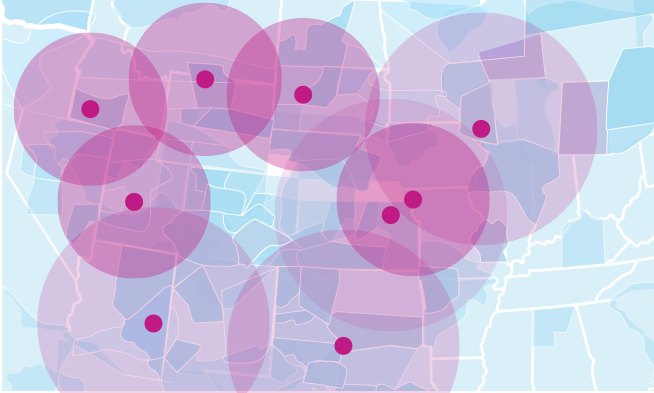

The welcoming gym
Overview:
With many locations clustered into urban centers, our fitness client—a national leader in self-service gyms—would regularly waste its media spend by competing against itself for the same prospects. We took a nuanced, multi-layered approach to geospatial targeting, helping to drive new member sign-ups and set a new standard in media efficiency.
Services:
- Geo analysis
- Spatial customer segmentation
- Data visualization
The challenge
As a fitness company with close to 100 locations across multiple cities, one of the many problems facing our client was determining where to find future members for their gyms. Current members were spread across a very large region, and the density of gym locations in urban areas caused significant overlaps in traditional media radius targeting. As such, reaching prospective customers was expensive and unrewarding. The company needed a more strategic way of targeting customers without creating competition between gym locations when bidding for media space.
- Build a deeper understanding of potential customers
- Accommodate specific, non-overlapping regions per franchise location
- Establish a new system to target media based on geo
The solution
We employed an iterative analysis process in which each insight was thoroughly tested before being built upon by future analyses. We began by challenging existing assumptions around the average time members were willing to drive to their registered gym location. To do that, we established additional spatial customer segments, such as users interested in joining a gym close to their places of work.
After building a complete understanding of potential customers, we dove deeper by using geo-coding and advanced geospatial analysis of where prospective customers should be targeted—and how these regions overlapped across gym locations. Ultimately, we arranged a postal code targeting media strategy that optimized franchise performance at the hyperlocal level.

MEMBERS FIRST
In order to generate new customers, we first had to understand existing customers that were already paying members of each club. We explored variables like how far they needed to drive from their home to the gym and which socio-economic groups they belonged to. Using our findings to create spatial segments—close to home, close to work, distance isn’t a problem—we started to paint a much clearer picture of the prospects that were most likely to become members.
SMART TARGETING
By overlaying postal code-level socio-economic data and the spatial customer segments, we were able to determine which regions had the most potential. This setup still enabled radius targeting, but was now guided more intelligently by customer potential within the radius.
SHARE THOSE GAINS
Each gym now had an optimal targeting region. However, these regions still overlapped, causing multiple gym locations to target the same individuals. We instigated postal code targeting media tactics and assigned the shared postal codes to gyms so that the potential market of each gym would be equal.
The Activist
The Advocate
The Engineer
The Pragmatist
The bold decision
- Optimized, hyper-local geotargeting mean that many clubs could actually spend fewer media dollars while successfully enrolling more paying customers
- In a break with conventional thinking, some of the locations with the largest member list could see the biggest reduction in advertising expenditures
Ready to get started?
We can help you create transformational change if your data has become an afterthought, untapped resource, or decision-making blind spot—and it all starts with a friendly chat. Let’s get started!
